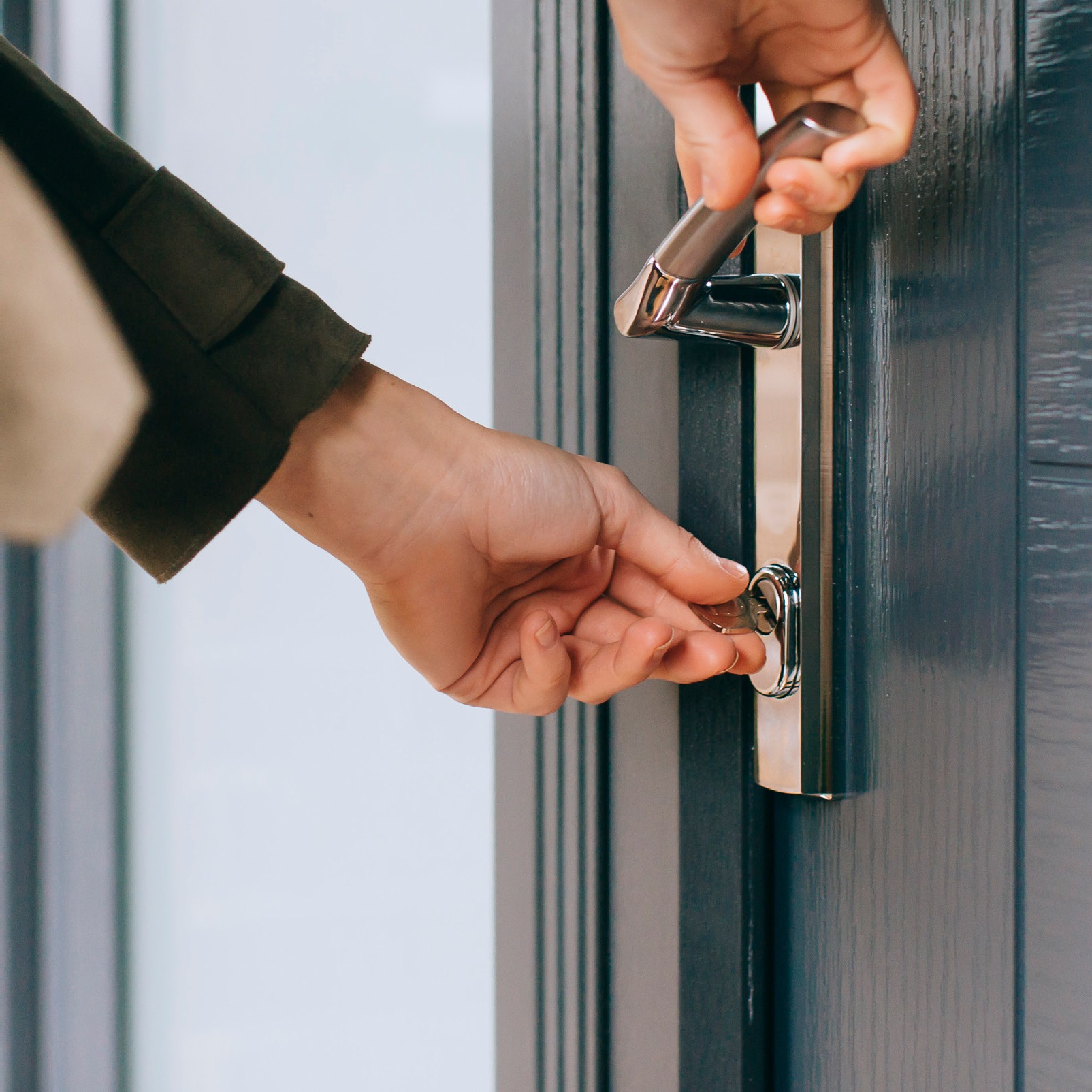Door Technology: From Basic Barriers to Smart Systems
Door technology, from the simplest wooden barriers to the most sophisticated smart locks, has a long and fascinating history. It’s a story of human ingenuity, driven by the need for […]
Door technology, from the simplest wooden barriers to the most sophisticated smart locks, has a long and fascinating history. It’s a story of human ingenuity, driven by the need for security, privacy, and convenience. Throughout the ages, doors have evolved alongside advancements in materials, mechanics, and technology. Today, we stand at the cusp of a new era, where doors are no longer just physical barriers but intelligent gateways integrated with our digital lives.
This exploration delves into the evolution of doors, exploring the diverse types, the integration of smart technology, and the future of door design. We’ll examine the security features, aesthetic considerations, and the exciting possibilities that lie ahead in the world of door technology.
Smart Door Technology
.jpg)
The integration of technology into modern doors has revolutionized home security, convenience, and accessibility. Smart door technology encompasses a range of features, from smart locks and automated opening systems to advanced security measures.
Smart Door Features
Smart doors incorporate various technological advancements to enhance functionality and security.
- Smart Locks: Smart locks replace traditional key-based locks with electronic systems that allow access through various methods, such as keycards, mobile apps, or biometric authentication. They offer enhanced security features like remote access control, activity logs, and customizable access permissions.
- Automated Opening Systems: These systems utilize sensors, actuators, and control systems to automate door opening and closing. This includes features like automatic door opening upon arrival, voice control, and integration with home automation systems.
- Security Features: Smart doors incorporate advanced security measures like motion sensors, video doorbells, and intrusion detection systems. These features provide real-time monitoring, alerts, and deter potential threats.
Benefits of Smart Door Technology
Smart door technology offers several benefits for homeowners, including:
- Enhanced Security: Smart locks and security features provide a robust defense against unauthorized access, reducing the risk of break-ins and theft.
- Convenience: Automated opening systems eliminate the need for keys, allowing for hands-free access and remote control. This is particularly beneficial for individuals with mobility limitations or busy schedules.
- Remote Access Control: Smart locks enable users to grant access to others remotely, allowing for convenient entry for guests, service providers, or family members.
- Increased Accessibility: Automated opening systems enhance accessibility for individuals with disabilities, making it easier for them to navigate their homes independently.
- Energy Efficiency: Smart door systems can integrate with home automation systems to optimize energy consumption by automatically closing doors and windows when not in use.
Challenges of Smart Door Technology
While offering numerous benefits, smart door technology also presents certain challenges:
- Security Concerns: Smart door systems rely on internet connectivity and software, which can be vulnerable to cyberattacks. Hackers could potentially gain unauthorized access to the system, compromising security.
- Privacy Issues: Smart door systems often collect data about user activity, such as access times and location. This raises concerns about privacy and data security.
- Technical Complexity: Setting up and maintaining smart door systems can be complex, requiring technical expertise and potentially involving multiple devices and platforms.
- Cost: Smart door technology can be expensive, especially when incorporating advanced features like automated opening systems and security cameras.
Hypothetical Smart Door System
Imagine a smart door system that seamlessly integrates with your home automation system, offering a comprehensive suite of features and functionalities:
- Biometric Authentication: The system utilizes facial recognition and fingerprint scanning for secure access, eliminating the need for keys or passwords.
- Automated Opening and Closing: The door automatically opens upon recognizing authorized users and closes securely behind them. It can also be controlled via voice commands or a mobile app.
- Integrated Security Features: The system incorporates motion sensors, video doorbells, and intrusion detection systems, providing real-time monitoring and alerts. It can also trigger automated responses, such as activating lights or calling emergency services.
- Remote Access Control: Users can grant temporary or permanent access to others remotely, managing access permissions through a secure mobile app.
- Energy Efficiency: The system integrates with the home automation system to automatically close the door when not in use, reducing energy loss and improving efficiency.
Door Security and Safety

Modern door technology plays a crucial role in enhancing home and business security, offering a range of features designed to deter unauthorized access and protect occupants. These advancements in door technology provide a comprehensive approach to security, combining traditional methods with innovative solutions.
Types of Door Locks
Door locks are the primary defense against unauthorized entry. They come in various forms, each offering unique security features and levels of protection.
- Traditional Key Locks: These locks are common and rely on a physical key to operate. They can be effective, but their security depends on the quality of the lock and the complexity of the key.
- Deadbolt Locks: Deadbolt locks are more secure than traditional key locks, as they have a separate locking mechanism that engages a bolt into the doorjamb. They are often used as an additional layer of security on exterior doors.
- Smart Locks: Smart locks use technology to enhance security and convenience. They can be unlocked using a smartphone app, a keypad, or even a fingerprint scanner. Smart locks offer features such as remote access, activity logging, and automatic locking.
- Lever Handles: Lever handles are popular for their ease of use, but they are generally less secure than deadbolts. They can be easily picked or forced open.
Access Control Systems
Access control systems are designed to manage entry and exit to specific areas, offering a more sophisticated approach to security.
- Keycard Systems: These systems use cards with embedded microchips to grant access. They are commonly used in office buildings, hotels, and other commercial settings.
- Biometric Systems: Biometric systems use unique biological characteristics, such as fingerprints, facial recognition, or iris scans, to authenticate users. They offer a high level of security and are increasingly popular for sensitive areas.
- Mobile Access Control: This technology allows users to control access to doors using a smartphone app. It offers flexibility and convenience, as users can grant access to others remotely.
Intrusion Detection Systems, Door technology
Intrusion detection systems are designed to detect and alert users to unauthorized entry. They use sensors to monitor for movement, sound, or other suspicious activity.
- Motion Sensors: Motion sensors detect movement within a specific area and trigger an alarm if unauthorized activity is detected. They are commonly used in hallways, doorways, and other areas where intruders might enter.
- Door and Window Sensors: These sensors are placed on doors and windows and trigger an alarm if they are opened without authorization.
- Glass Break Sensors: Glass break sensors detect the sound of breaking glass and trigger an alarm. They are particularly useful for protecting windows and glass doors.
Best Practices for Securing Doors
- Install Strong Doors: Solid core doors are more resistant to forced entry than hollow core doors.
- Use High-Quality Locks: Choose locks with a high security rating and ensure they are properly installed.
- Reinforce Doorjambs: Ensure the doorjambs are strong enough to resist force and that the screws holding the door hinges are long and secure.
- Install Security Cameras: Security cameras can deter crime and provide evidence in the event of an intrusion.
- Consider an Alarm System: An alarm system can alert you and authorities if an intruder enters your home or business.
Concluding Remarks
The future of door technology is brimming with exciting possibilities. As artificial intelligence, robotics, and biometrics become more prevalent, doors will become even more intelligent, secure, and convenient. From self-locking doors that anticipate your needs to biometric access systems that recognize your unique features, the possibilities are endless. The evolution of door technology is a testament to our relentless pursuit of innovation and a glimpse into a future where doors become seamless extensions of our connected world.
Door technology has come a long way, from simple locks to smart home integration. When comparing the Atlas SEL and SE, you’ll find that the SEL boasts more advanced features like keyless entry and remote start, which are perfect for those who value convenience and security.
Learn more about the technological differences between the Atlas SEL and SE to see which model best suits your needs. Ultimately, the best door technology is the one that meets your specific requirements and enhances your daily life.










